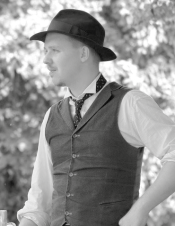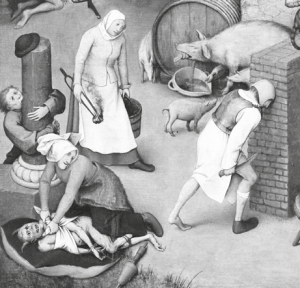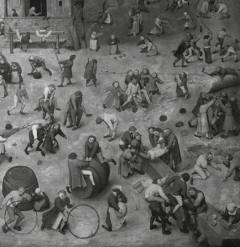
Do you have happy memories of your studies at Catholic Theological Faculty of Charles University?
I do, definitely. Sometimes it was fun, other times quite difficult and sometimes it made me angry. (laughter) But it was very good, and I think there was a wonderful bunch of people. I have been in touch with some schoolmates, and I know that I can ask any of them for help anytime. I also have happy memories of our student events – for example seminars in the Broumov region, or here in Letařovice, or theatre with the associate professor Sládek. These are the unforgettable experiences. I also remember the lectures and lecturers, I don’t want to miss out anybody, but I remember for example professor Royt, professor Petráček, doctor Kubík, doctor Doležal and of course my thesis supervisor professor Beneš. It was professor Beneš and associate professor Sládek who told us something which remained in my memory: Lecturers try to pass on knowledge and sometimes they are successful and sometimes not (laughter) but they also set an example how to handle the knowledge and pass it on. I try to do this in my life and during my activities and sometimes to pass something on.
Have you always been attracted to history studies?
Yes, I can say I have always liked history. It started with family memories over old photographs, for example from my parents’ or grandparents’ childhood. Micro stories of my family – that was what sparked my interest in history. At secondary grammar school, I had already been a typical history swot (laughter). So I have always been attracted to history.
How did you as a “Prague person” get to the Podještědí region?
I like the neighbouring region – Český Ráj because we had a cottage near Jičín and as a child I spent a lot of time there. It’s not far from here, and it is a similar type of countryside. At secondary school, we had a school trip to Český Dub, which is actually the centre of Podještědí or Českodubsko region. The place moved my heart. We visited the local sights and saw other interesting places, such as Johanite Commandery or old empty Sudeten German houses, a beautiful atmosphere everywhere. The whole area was interesting for me – old delipidating cottages we explored with my schoolmates. We found there various old artefacts left behind by the original owners and we invented the stories connected with them.
Was it there where you decided to establish the Dubáci fellowship which you preside? Could you tell us something about this fellowship?
After that I visited the area more and more often and was thinking what could be done there. It was kind of looking for a reason why to go there, not to go there for nothing.

Pieter Bruegel the Elder, Netherlandish Proverbs, 1559, Gemäldegalerie, BerlinStill at grammar school, we thought of a film with my mates which we shot here about the local history. A friend of mine is a musician, so it was a kind of historical musical (laughter). It brought me even closer to the region. When we were shooting the film, we explored the whole area. We noticed wayside crosses which were everywhere around and dilapidating gradually as nobody looked after them. It inspired me to initiate a repair of one of them – Baroque St John’s column situated in the countryside, on a hill with a beautiful view of Ještěd and Český Dub. Doing so, I was noticed by other people from the surrounding villages and in 2012 we established the Dubáci fellowship.
It is called Dubáci, because Český Dub is a kind of the natural centre of the area. Basically, we try to help to preserve the natural heritage and cultural sights. It does not mean only preservation of material heritage, such as pedestals, stones and beams, but returning the original significance to the sights. And if not the original one, perhaps a new one. When a wayside cross is being renovated, I try to inform the local people about it. It is the main purpose – to realize there are interesting places which were not noticed before and form a relationship to them.
It is also related to our activities connected with the reconstruction of St Jacob’s Church in Letařovice, which was in disrepair. There we started to organise (when I was still studying the first years of Catholic Theological Faculty) a festival called “Pouť mezi dvěma Jány”, which is a kind of small cultural festival. A great help came from the associate professor Miloš Sládek – he recommended Baroque musicians, came to give lectures and performed with his student theatre. Professor Royt also comes to lecture at the festival. Local people look forward to this event every year.
First you reconstructed smaller sights in the surroundings. How did you get the idea of reconstructing Beran’s inn in Trávníček?
A big topic here in south part of Českodubsko region is folk architecture, because beyond Ještěd there are German areas, former borderland, where often the whole villages are quite preserved because the people left the area. Then other people bought them as weekend houses and they look after them quite well. Here in the Českodubsko region there was no expulsion or just minimum. The houses are held by the original families. It means that sometimes they are neglected, dilapidating and collapsing. Because they are reconstructed and adapted. It is a logical step. At the same time, the local folk architecture is very precious, interesting and specific.
In the village of Trávníček, not so many original houses were destroyed. Specialist literature even refers to Trávníček as a natural open-air museum of folk architecture in the Podještědí region. We knew there was a beautiful old inn in Trávníček which had been dilapidating and falling into ruin. When it went for sale, we saw it as a challenge. Save a folk architecture sight, show how it was done before in a traditional way and show the people that it is possible to rescue such a building. Dubáci association did not have a place for its activities where it could present itself. For example, after the event in Letařovice we did not have anywhere to go. At the end of an event, we always had to meet in front of sacristy (laughter). Now it’s fine, we will have a clubroom.
At events, you perform as Beran, the innkeeper after whom the inn is called. Who was Antonín Beran?
I did a historical research about the innkeeper Antonín Beran in archives, so I learned quite a lot about him. The Berans lived there for several hundred years and Antonín Beran was the last of them. He died of tuberculosis at 39 after having reconstructed the whole inn and got it running. His children died as well, the family had quite a tragic fate. After more than 100 years we follow what the innkeeper Beran left behind, as there was nobody left to do it.
The fellowship has been given several awards for the inn reconstruction. I would mention mainly the prize Patrimonium pro futuro from the National Heritage Institute in the category of Historic Building Conversation and in the category Public Choice Award.
Your activities follow the start of the 20th century – is this era a kind of model what the inn should look like?
The building had an advantage and somewhat a disadvantage at the same time that its owner did not maintain the house at all and it was on the verge of collapsing. We had to replace many beams and some rooms had to be reconstructed completely. On the other hand, it was preserved in its authentic form from the start of the 20th century when its last big reconstruction was made. The engineers Pešta and Efler, who did the historical research of the inn building, said: “We always ask where we should go back to in the reconstruction.” And this building has the most preserved part from the start of the 20th century. We have an advertising postcard made perhaps by the innkeeper Beran, from between 1905 and 1908, and it is our aim to achieve. In the interior, there are clay plasters with preserved original stencil paintings, very complicated Art Nouveau motifs. When you enter the inn where the paintings have been partially renovated, you have a feeling you are rather in a mansion, not in a cottage. All these aspects determined that we would like to renovate the state from 1905. It is connected with many things, for example the original open-hearth kitchen was used as a taproom. In Beran’s time, this type of kitchens had already become unfashionable. And because he had little space in the hall and the taproom would be in the way of dancers, he situated it in the former open-hearth kitchen. We found the pipes going from the cellar straight to that kitchen. So we will reconstruct the inn with this untraditional layout. It is also a reason why we call this project a museum with a taproom. It won’t be run as a standard pub because our reconstruction efforts would not be seen. A visitor will be able to have a draft beer from one brass tap, in the same way as the innkeeper Beran had it.
Many cultural events are held at the inn. If we had a normal year, which events were you planning to do?
Now we would have had the sixth year of carnival here in Trávníček. I’m still preparing the 10th year of the funfair Mezi dvěma Jány, which is supposed to be at the beginning of June. If it works out, it will be very tight. Even last year was rather minimalist, it was immediately after the lockdown, we will see.
In summer we organise events directly in Trávníček outside the Beran’s inn. We take part in Folk Architecture Days in July. And other times we just do there what comes into our mind (laughter).
You wrote the book Příběhy podještědské obce I. which became the book of the year in the Liberec Region in 2019. Is its part two coming out soon?

Pieter Bruegel the Elder, Children’s Games, 1560, Kunsthistorisches Museum, ViennaYes, it is. The first part is based on my bachelor and diploma work. Altogether there should be three parts and it is supposed to be history of the village of Bílá under which we belong and which historically comprises of six various villages that were united under the central village in the socialist era. In the individual parts I will be dealing with these smaller villages and municipalities. In the first part you can read about Trávníček and Letařovice. The second part is a new challenge for me and interesting experience. From my point of view, it is a largely unexplored topic, so to say. In the first part, I had pre-prepared material from my previous work. Now I am starting from scratch, all the bibliography, archive work and interviews with those who remember old times and other things. There is a lot of work, but it is refreshing for me to discover other parts of this area and form relationship to it.
You are a historian, the chairman of a fellowship but also a brewer. What beer do you brew? Do we have to come to Trávníček for it?
The brewery was established because we had been thinking about the economic results of our fellowship activities and we realized that we cannot do it for living. So, the idea came from the inn reconstruction – the connection with beer. Coincidently, there were a few brewers in our surroundings and they told us: ”You could establish a flying brewery”. A flying brewery means that we have our own recipe, but beer brewing is leased to various other breweries. We liked the idea and in 2018 we established Beran’s Brewery, as a tribute to Antonín Beran. And also because we have Beran’s Inn and there is also Beran’s Mill in the village, not connected with us. So Beran’s Brewery is completing the series (laughter). At the moment we are preparing construction of a brick-and-mortar brewery, if circumstances allow. Our brewers make very good beer, we supply to Prague as well. Every Thursday we can deliver anywhere.
The text was first published in DOXA vol. 7, no. 2, june 2021, pp. 17-18.